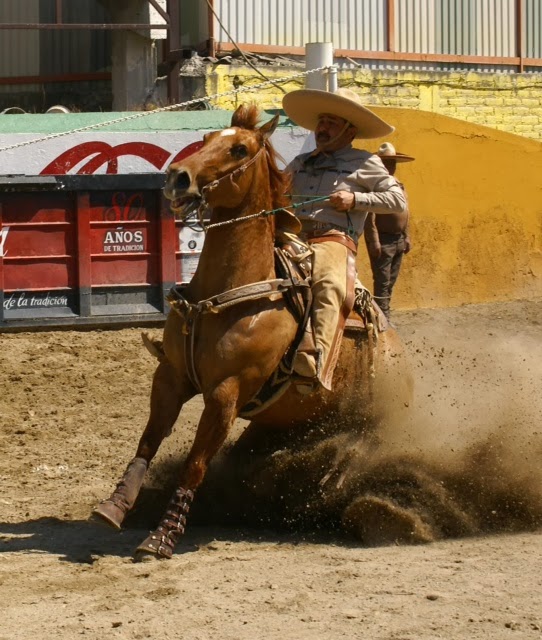In every rodeo I ever saw, a cowboy who wants to take down a running steer dives off his horse onto the animal's neck and twists its head by the horns until it falls over. But Mexican charros dress much fancier and prefer not to leave their saddles, so they do things differently here.
The horse and rider stand by a gate where a young bull is waiting to bolt. When the gate opens, horse and bull break at once into a pell mell gallop. In the first strides, the rider reaches down with his right hand and grabs the bull's tail.
Then he straightens in the saddle and swings his right leg over and around the tautened tail. That creates enough leverage that when the horse lengthens its stride to pull ahead, the bull's hindquarters are yanked sideways and it capsizes in a cloud of dust.
This short race takes place along a wall marked for distance. Generally the beef is off the hoof somewhere between 30 and 50 meters, the less the better for scoring purposes.
I watched this trick performed a dozen or more times this weekend at the Campeonata Nacional Charro, the national cowboy championship held at a special arena about an hour east of here. This part of Jalisco state isn't really what you could call cattle country, but I guess cowboys like to go to the beach too.
It was quite a spectacle, not so much a rodeo as a combination of dressage and folkloric dance. I really went because I wanted to see live escaramuza, the women's event featuring a team of riders dressed in boot length dresses and petticoats executing precision sidesaddle maneuvers in which they repeatedly almost collide but never do. It was as lovely as I hoped.
But all the events in one way or another were about riders working in intimate partnership with their mounts to perform a complicated choreographed task. One involved galloping to a chalk line, where the horse instantly lowers its hindquarters, stiffens its back legs and slides to a stop.
That's what the charro in the cribbed photo above from some other charreada is doing. (My own pictures were even worse than usual.) Judges then measure the skid marks to score the performance. The best distances while I was watching were about 16 meters.
In another phase of competition, the charro sat his horse waving a lariat and waiting for a horse to gallop past about 10 meters in front of him. His job was to toss the loop so it caught the two rear legs of his running target. I saw 15 or 20 men make the attempt. Only one missed. (The horses never went down. They just ran a few indignant tricycle strides and then kicked off the rope.)
It all looked elegant and easy. The charros in their embroidered pants, white shirts and floppy bow ties were studies in dignity and perfect posture. The horses were so casual in their discipline that it almost looked like joy. One of them even danced to the live oompah music coming from the bandstand while he waited with his rider for their event to start.
But although it looked like poetry, it was also physics. We had almost forgotten that matter in motion in these dimensions is risky for all concerned.
Then one of the tumbling bulls in the "tailing" competition apparently rolled into the right hind leg of the horse who upended him. As the charro emerged from the course, his mount limped, staggered and went over on its side.
A dozen charros immediately swarmed to the fallen horse and rider, stripped away the saddle and tack and cradled the animal's head while a veterinarian came to survey the damage.
After a minute or two, the horse struggled upright to some scattered applause, but a good part of the crowd were ranch people who knew better and watched in silence. The leg was broken right through and dangled uselessly for the few sad moments it took the horse to go down again.
The vet administered an injection, and after a short interval of waiting while it took effect, a couple of mounted charros got busy with lariats to clear the arena.
Then they struck up the band again.

No comments:
Post a Comment